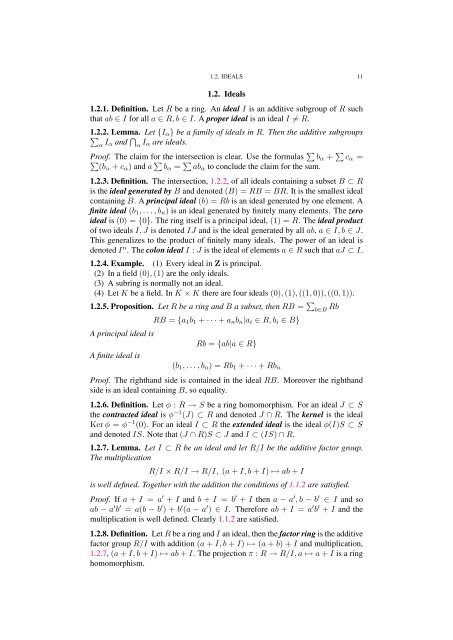Commutative algebra - Department of Mathematical Sciences - old ...
Commutative algebra - Department of Mathematical Sciences - old ...
Commutative algebra - Department of Mathematical Sciences - old ...
You also want an ePaper? Increase the reach of your titles
YUMPU automatically turns print PDFs into web optimized ePapers that Google loves.
1.2. IDEALS 11<br />
1.2. Ideals<br />
1.2.1. Definition. Let R be a ring. An ideal I is an additive subgroup <strong>of</strong> R such<br />
that ab ∈ I for all a ∈ R, b ∈ I. A proper ideal is an ideal I = R.<br />
1.2.2.<br />
<br />
Lemma. Let {Iα} be a family <strong>of</strong> ideals in R. Then the additive subgroups<br />
α Iα and <br />
α Iα are ideals.<br />
Pro<strong>of</strong>. The claim for the intersection is clear. Use the formulas bα + cα =<br />
(bα + cα) and a bα = abα to conclude the claim for the sum.<br />
1.2.3. Definition. The intersection, 1.2.2, <strong>of</strong> all ideals containing a subset B ⊂ R<br />
is the ideal generated by B and denoted (B) = RB = BR. It is the smallest ideal<br />
containing B. A principal ideal (b) = Rb is an ideal generated by one element. A<br />
finite ideal (b1, . . . , bn) is an ideal generated by finitely many elements. The zero<br />
ideal is (0) = {0}. The ring itself is a principal ideal, (1) = R. The ideal product<br />
<strong>of</strong> two ideals I, J is denoted IJ and is the ideal generated by all ab, a ∈ I, b ∈ J.<br />
This generalizes to the product <strong>of</strong> finitely many ideals. The power <strong>of</strong> an ideal is<br />
denoted I n . The colon ideal I : J is the ideal <strong>of</strong> elements a ∈ R such that aJ ⊂ I.<br />
1.2.4. Example. (1) Every ideal in Z is principal.<br />
(2) In a field (0), (1) are the only ideals.<br />
(3) A subring is normally not an ideal.<br />
(4) Let K be a field. In K × K there are four ideals (0), (1), ((1, 0)), ((0, 1)).<br />
1.2.5. Proposition. Let R be a ring and B a subset, then RB = <br />
b∈B Rb<br />
A principal ideal is<br />
A finite ideal is<br />
RB = {a1b1 + · · · + anbn|ai ∈ R, bi ∈ B}<br />
Rb = {ab|a ∈ R}<br />
(b1, . . . , bn) = Rb1 + · · · + Rbn<br />
Pro<strong>of</strong>. The righthand side is contained in the ideal RB. Moreover the righthand<br />
side is an ideal containing B, so equality.<br />
1.2.6. Definition. Let φ : R → S be a ring homomorphism. For an ideal J ⊂ S<br />
the contracted ideal is φ −1 (J) ⊂ R and denoted J ∩ R. The kernel is the ideal<br />
Ker φ = φ −1 (0). For an ideal I ⊂ R the extended ideal is the ideal φ(I)S ⊂ S<br />
and denoted IS. Note that (J ∩ R)S ⊂ J and I ⊂ (IS) ∩ R.<br />
1.2.7. Lemma. Let I ⊂ R be an ideal and let R/I be the additive factor group.<br />
The multiplication<br />
R/I × R/I → R/I, (a + I, b + I) ↦→ ab + I<br />
is well defined. Together with the addition the conditions <strong>of</strong> 1.1.2 are satisfied.<br />
Pro<strong>of</strong>. If a + I = a ′ + I and b + I = b ′ + I then a − a ′ , b − b ′ ∈ I and so<br />
ab − a ′ b ′ = a(b − b ′ ) + b ′ (a − a ′ ) ∈ I. Therefore ab + I = a ′ b ′ + I and the<br />
multiplication is well defined. Clearly 1.1.2 are satisfied.<br />
1.2.8. Definition. Let R be a ring and I an ideal, then the factor ring is the additive<br />
factor group R/I with addition (a + I, b + I) ↦→ (a + b) + I and multiplication,<br />
1.2.7, (a + I, b + I) ↦→ ab + I. The projection π : R → R/I, a ↦→ a + I is a ring<br />
homomorphism.
















